Chevrolet Greenbrier
| Corvair Greenbrier | |
|---|---|
 |
|
| Overview | |
| Production | 1961–1965 |
| Body and chassis | |
| Body style |
|
| Layout | RR layout |
| Platform | Y-body |
| Related | Chevrolet Corvair, Chevrolet Apache |
| Powertrain | |
| Engine | |
| Transmission |
|
| Dimensions | |
| Wheelbase | 95 in (2,413.0 mm) |
| Length |
|
| Width | 70 in (1,778.0 mm) |
| Height |
|
The name Chevrolet Greenbrier was used by Chevrolet for two vehicles. The first vehicles were a van and pickup truck based on the Corvair, produced between model years 1961 to 1965. The Greenbrier name was used a second time from 1969 until 1972; for the mid level Chevelle station wagon.
Chevrolet introduced the Corvair lineup for the 1960 model year as the first of a series of generations of passenger compact cars. Chevrolet introduced a more utilitarian style of vehicle the following year under the model designation "Corvair 95". In appearance and design the vehicles were similar to the competing Volkswagen Transporter, which was essentially a bus-like adaptation of the Volkswagen Beetle that moved the driver over the front wheels (Forward control), also commonly defined as a cab over vehicle.
The Corvair air-cooled horizontally opposed 6-cylinder engine was located in the rear of the vehicle under a slightly raised cargo floor. It was similar in principle to the 4-cylinder engine of the Volkswagen, but unusual for most contemporary cars. The 145 cu in (2,375 cc) engine developed 80 hp (60 kW) at 4,400 rpm. Engine size was increased to 164 cu in (2,683 cc) for the 1964 model year, raising output to 95 hp (71 kW). Unlike the Corvair cars, the Corvair Greenbrier had a 95 in (2,400 mm) wheelbase and were thus known as "95s." They came standard with a three-speed manual transmission but could be ordered with a two-speed Corvair Powerglide automatic transmission (distinct from the usual Powerglide); eventually a four-speed manual was also made available.
There were essentially two different bodies available in the 95 series: the van and the truck. The base version was the panel van (Corvan) with no side or rear windows. The van was named Greenbrier. The Greenbrier normally had windows all around and six doors, although an option was to have eight doors where there were opening double doors on both sides. The Greenbrier seated up to nine people with the available third-row seat. The 95s and cars had an optional heater running off of gasoline from the vehicle's tank. The Greenbrier also had a camper option.
...
Wikipedia

